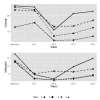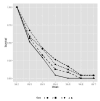Opioid withdrawal, craving, and use during and after outpatient buprenorphine stabilization and taper: a discrete survival and growth mixture model
- PMID: 25282598
- PMCID: PMC4252696
- DOI: 10.1016/j.addbeh.2014.09.021
Opioid withdrawal, craving, and use during and after outpatient buprenorphine stabilization and taper: a discrete survival and growth mixture model
Abstract
Introduction: Most patients relapse to opioids within one month of opioid agonist detoxification, making the antecedents and parallel processes of first use critical for investigation. Craving and withdrawal are often studied in relationship to opioid outcomes, and a novel analytic strategy applied to these two phenomena may indicate targeted intervention strategies.
Methods: Specifically, this secondary data analysis of the Prescription Opioid Addiction Treatment Study used a discrete-time mixture analysis with time-to-first opioid use (survival) simultaneously predicted by craving and withdrawal growth trajectories. This analysis characterized heterogeneity among prescription opioid-dependent individuals (N=653) into latent classes (i.e., latent class analysis [LCA]) during and after buprenorphine/naloxone stabilization and taper.
Results: A 4-latent class solution was selected for overall model fit and clinical parsimony. In order of shortest to longest time-to-first use, the 4 classes were characterized as 1) high craving and withdrawal, 2) intermediate craving and withdrawal, 3) high initial craving with low craving and withdrawal trajectories and 4) a low initial craving with low craving and withdrawal trajectories. Odds ratio calculations showed statistically significant differences in time-to-first use across classes.
Conclusions: Generally, participants with lower baseline levels and greater decreases in craving and withdrawal during stabilization combined with slower craving and withdrawal rebound during buprenorphine taper remained opioid-free longer. This exploratory work expanded on the importance of monitoring craving and withdrawal during buprenorphine induction, stabilization, and taper. Future research may allow individually tailored and timely interventions to be developed to extend time-to-first opioid use.
Keywords: Buprenorphine; Craving; Latent class; Opioid; Relapse; Withdrawal.
Copyright © 2014 Elsevier Ltd. All rights reserved.
Conflict of interest statement
Figures



References
Publication types
MeSH terms
Substances
Grants and funding
LinkOut - more resources
Full Text Sources
Other Literature Sources
Medical
Research Materials

